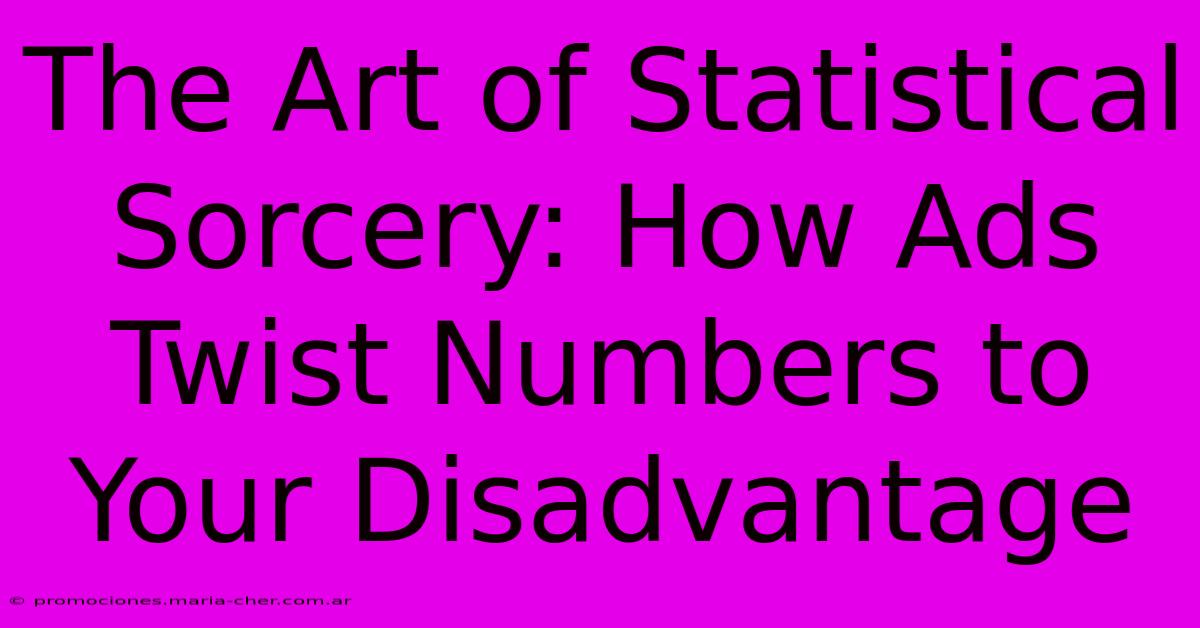The Art Of Statistical Sorcery: How Ads Twist Numbers To Your Disadvantage

Table of Contents
The Art of Statistical Sorcery: How Ads Twist Numbers to Your Disadvantage
We're bombarded daily with advertising, each claim vying for our attention. But how many of these claims stand up to scrutiny? Often, the answer is: not many. Advertisers are masters of using statistics, not to inform, but to misinform, employing a subtle form of "statistical sorcery" to manipulate our perceptions and loosen our wallets. This article delves into the common tricks used and equips you with the critical thinking skills to resist their charms.
The Sleight of Hand: Common Statistical Tricks in Advertising
Advertisers skillfully employ several techniques to distort the truth with numbers. Here are some of the most prevalent:
1. Misleading Percentages: The "Up to" Deception
Ever seen an ad boasting "Up to 50% off"? This vague phrasing is a classic example. It implies significant savings, yet the actual discount might apply to only a tiny fraction of items, leaving the vast majority with minimal reductions or none at all. Always look for specifics. Avoid vague marketing claims lacking concrete data.
2. Cherry-Picking Data: Showing Only What's Convenient
Imagine an ad showcasing testimonials focusing solely on positive experiences, ignoring the negative feedback. This is cherry-picking data – selecting only the information that supports the desired narrative while conveniently omitting any contradictory evidence. Be wary of unqualified testimonials and lack of data transparency. A reliable company will provide comprehensive reviews or studies.
3. Irrelevant Comparisons: The "Better Than Nothing" Trap
Sometimes, advertisers compare their product to a ridiculously inferior alternative to make it seem superior. For example, claiming "Our toothpaste is better than brushing with water!" This is a meaningless comparison; the real question is whether it's superior to other toothpastes. Always evaluate claims against realistic competitors, not straw man arguments.
4. Confusing Correlation with Causation: The "Post Hoc Ergo Propter Hoc" Fallacy
This age-old fallacy assumes that because two things happen together, one caused the other. An ad might claim that using a certain skincare product led to glowing skin, ignoring other contributing factors like diet, genetics, or lifestyle. Correlation doesn't equal causation. Demand evidence of a true causal link, not just coincidental association.
5. Playing with Sample Sizes: Small Numbers, Big Claims
A small, unrepresentative sample can lead to wildly inaccurate conclusions. An ad might showcase results from a study of only ten people, then extrapolate those findings to the entire population. Be skeptical of studies with tiny sample sizes. Larger, more diverse samples provide more reliable results.
The Antidote: Developing Your Statistical Immunity
Becoming a savvy consumer requires developing a healthy skepticism towards advertising claims. Here's how:
-
Question Everything: Don't passively accept claims at face value. Ask yourself: What data supports this? Where is the evidence? How was this data collected?
-
Look for the Fine Print: Advertisers often hide important details in the small print. Read it carefully before making any decisions.
-
Seek Independent Verification: Don't rely solely on the advertiser's claims. Look for independent reviews, comparisons, and scientific studies to corroborate their statements.
-
Understand Basic Statistics: Learning about averages, percentages, and sample sizes can significantly improve your ability to interpret data critically.
-
Be Aware of Cognitive Biases: We're all susceptible to cognitive biases, such as confirmation bias (favoring information confirming our beliefs). Consciously strive to be objective and consider alternative perspectives.
Conclusion: Becoming a Critical Consumer
The art of statistical sorcery is a powerful tool, but with awareness and critical thinking, we can effectively disarm it. By understanding the common tactics advertisers use and by developing our ability to analyze data critically, we can become more informed and empowered consumers, protecting ourselves from manipulative marketing techniques. The power to resist the allure of misleading advertising lies in our hands. Let's wield it wisely.

Thank you for visiting our website wich cover about The Art Of Statistical Sorcery: How Ads Twist Numbers To Your Disadvantage. We hope the information provided has been useful to you. Feel free to contact us if you have any questions or need further assistance. See you next time and dont miss to bookmark.
Featured Posts
-
Embrace The Blue Hue Of Camaraderie Crafting Friendship Bracelets For Unbreakable Bonds
Feb 08, 2025
-
From Humble Weeds To Celestial Wonders The Unbelievable True Story Of Million Star Babys Breath
Feb 08, 2025
-
Monster Size Your Marketing A Guide To Creating Signs That Rule
Feb 08, 2025
-
Say Goodbye To Web P Headaches Our Converter Makes Jpg Conversion A Breeze
Feb 08, 2025
-
Affordable Luxury The Ageless Appeal Of Gold Dainty Bracelets For Every Budget
Feb 08, 2025
